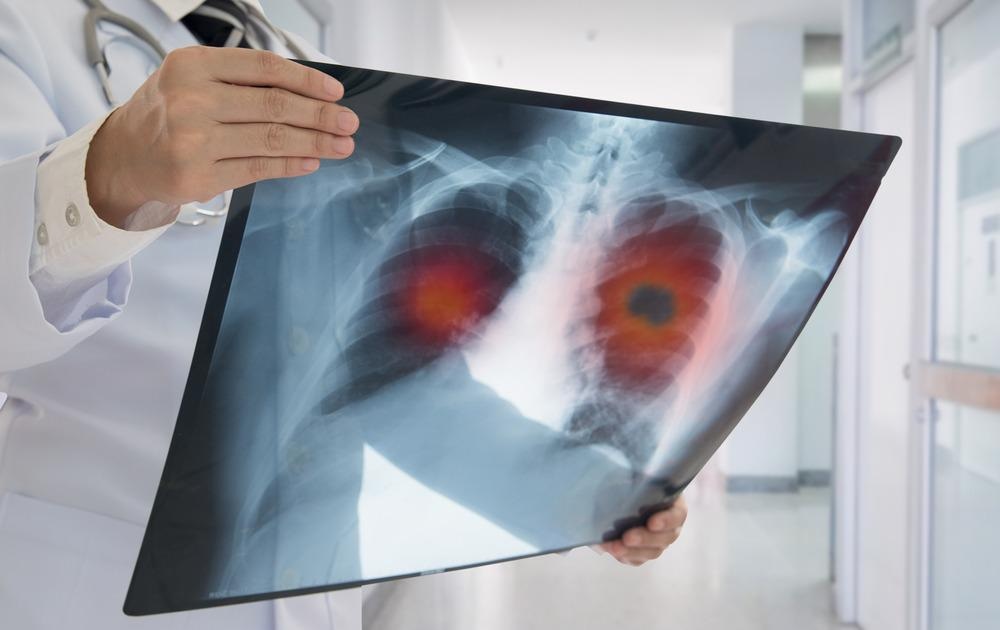In a recent study published in the journal Langmuir, researchers developed a new photosensitive nanoprobe for effective targeted drug accumulation, optimal thermal conversion efficiency, and singlet oxygen generation for the photodynamic or photothermal treatment during lung cancer treatment.

Study: A Novel Nanoprobe for Targeted Imaging and Photothermal/Photodynamic Therapy of Lung Cancer. Image Credit: create jobs 51/Shutterstock.com
The nanoprobe consists of near-infrared (NIR) photosensitive drug indocyanine green (ICG), porous drug carrier ferric oxide (Fe3O4) nanoparticles, and a modifier hyaluronic acid (HA)
It was also demonstrated to exhibit excellent ICG loading, stability in organic solvents, and specific targeting to the lung cancer cells under 808 nm laser irradiation.
Photothermal and Photodynamic Lung Cancer Treatment
Currently, ICG is the most commonly used hydrophobic NIR photosensitive reagent in photothermal (PTT) and photodynamic (PDT) therapy-based diagnosis, treatment, and early detection of tumors.
In PTT, ICG efficiently converts light energy into heat, whereas in PDT, it uses light energy to generate singlet (least excited) oxygen molecules at a specific irradiation wavelength of NIR. However, its nanoprobing and sanative applications are hindered by its several characteristics, such as instability, agglomeration, and decomposition in the polar solvents, poor tumor-targeting ability, and rapid withering in the plasma medium owing to its low half-life of 2−4 min.
As a solution, Fe3O4 nanoparticles, which are widely used in nuclear magnetic resonance (NMR) as a contrasting agent, can be chemically etched to form porous structure and employed as the drug carrier of ICG to affect specific organs, tissues, or cells under the effect of an adscititious magnetic field.
Moreover, a major component of the extracellular matrix, HA, can be used as a modifier and ICG-protective agent to the Fe/ICG complex owing to its biocompatibility, biodegradability, and binding nature to the overpopulated CD44 receptors on the surface of the mutated cells.
About the Study
In this study, the researchers synthesized the Fe/ICG@HA complex for the targeted delivery of drugs to lung cancer cells. First, the Fe3O4 nanoparticles with uniform size and dispersibility were synthesized from FeCl2·4H2O, FeCl3·6H2O, poly(ethylene glycol) (PEG), and diluted ammonia using the coprecipitation method at 50 °C.
After that, porous Fe3O4 nanoparticles were synthesized using ammonium acetate as the etching agent, followed by loading of ICG into the corresponding nanopores. Finally, the Fe/ICG@HA complex was synthesized by suspending Fe/ICG in 10 mL of deionized water containing HA (0.5 mg/mL) for several hours.
Subsequently, the prepared nanoprobe complex was characterized, and its biocompatibility, biodegradability, cellular uptake, T2-MR imaging, in vitro, and in vivo treatment were analyzed against the cultured A549 cells.
The fluorescence intensity inside the A549 cells was quantitatively was analyzed by flow cytometry after several intervals of time.
Observations
Transmission electron microscopy (TEM) and scanning electron microscopy (SEM) images showed that the Fe/ICG@HA complex exhibited a blurred microstructure with a clear organic layer after ICG loading and HA modification, indicating successful loading of the two materials on the porous Fe3O4 nanoparticles.
The UV−vis analysis revealed an ICG loading of 17.6% and a temperature of 61.5 °C on the Fe3O4 nanoparticles. The CCK-8 and apoptosis analysis revealed that ICG had no noticeable cytotoxicity in the concentration range of 0−40 μg/mL and less than 2% apoptotic cells at the highest concentration, proving excellent biocompatibility.
Furthermore, the internal fluorescence of the A549 cells incubated by the Fe/ICG@HA complex with 808 nm laser irradiation was stronger than that for the pure ICG complex.
Also, the intensity of fluorescence emission had a direct dependency on the duration of incubation inside the A549 cells.
The fluorescence intensity after incubation of 12 hours was significantly stronger than after 2 hours.
The in vitro analysis using cell double-staining and a laser confocal microscope revealed a large number of dead cancer cells for Fe/ICG@HA complex than pure ICG and pure Fe3O4 nanoparticles.
Conclusions
In summary, the researchers of this study synthesized Fe/ICG@HA complex for PTT and PDT-based diagnosis and treatment of lung cancer cells such as the A549 cells.
Under the 808 nm laser irradiation, the Fe/ICG@HA complex exhibited better incubation-time-dependent fluorescence intensity, targeted imaging and killing of cancer cells, excellent biocompatibility, long-duration drug retentivity, satisfactory ICG drug loading of 17.6%, and no cytotoxicity. Thus, Fe/ICG@HA complex nanoprobe is a promising candidate for precision photo-theranostics of lung cancer.
Continue reading: Progressing Pulmonary Drug Delivery with Nanoparticles.
Reference
Sun, X., Xu, Y., Guo, Q., Wang, N., Wu, B., Zhu, C., Zhao, W., Qiang, W., Zheng, M., (2022) A Novel Nanoprobe for Targeted Imaging and Photothermal/Photodynamic Therapy of Lung Cancer, Langmuir. Available at: https://pubs.acs.org/doi/10.1021/acs.langmuir.1c02434
Disclaimer: The views expressed here are those of the author expressed in their private capacity and do not necessarily represent the views of AZoM.com Limited T/A AZoNetwork the owner and operator of this website. This disclaimer forms part of the Terms and conditions of use of this website.